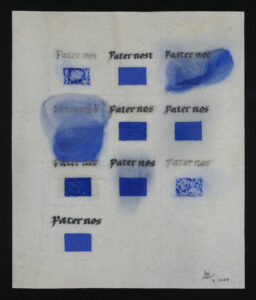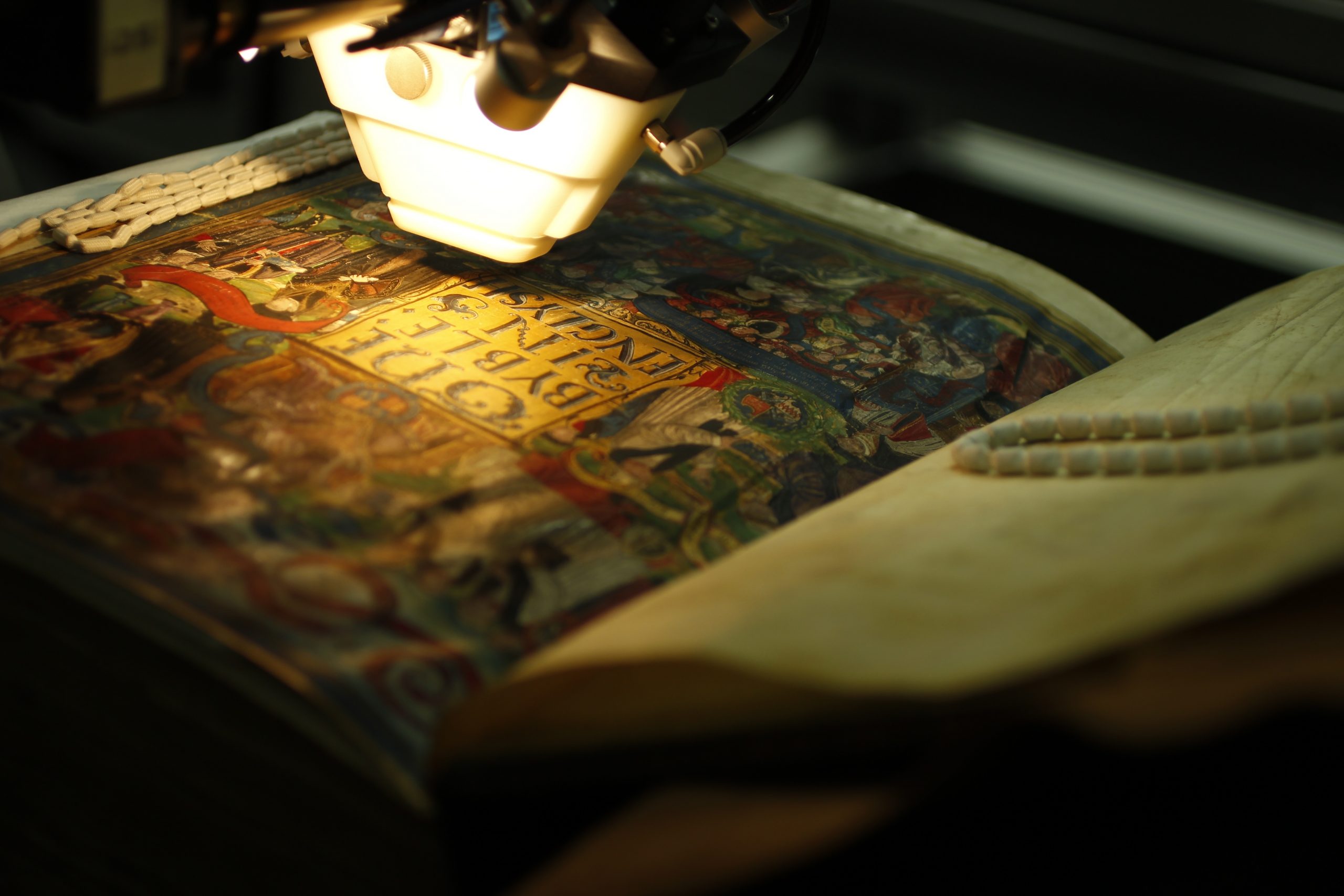HiPS at IMC Leeds 2025
The Hidden in Plain Sight project is thrilled to announce three key events at the International Medieval Congress (IMC) 2025 in Leeds, offering a unique opportunity to explore the groundbreaking use of innovative technologies in the study of medieval manuscripts and objects. These events are free to attend but spaces are limited. Don’t miss the chance to discover how new technologies are revolutionising our understanding of medieval manuscripts.
1. Scratching the Surface – Hands-On Exploration
Tuesday, 8 July 2025 | 16:30 – 18:00
Location: Parkinson Building: Treasures of the Brotherton Gallery
Free of Charge
Join the Hidden in Plain Sight project team for a hands-on exploration of medieval manuscripts using complex imaging techniques. This session will take place in the Sheppard Room of the Treasures of the Brotherton Gallery, where manuscripts from Leeds University Special Collections will be examined under various imaging techniques to reveal the intricate surface features of the medieval codices.
Led by imaging specialists Amélie Deblauwe and Maciej Pawlikowski, together with historian Eyal Poleg, this session will explore how new technologies, specifically photometric stereoscopy and Reflectance Transformation Imaging (RTI), can uncover hidden traces of the past. Discover how scribes, readers, and even the surrounding environment have left their mark on these medieval manuscripts.
2. Reception: Meet the Hidden in Plain Sight Research Team
Tuesday, 8 July 2025 | 18:30 – 19:30
Location: University House: St George Room
After the “Scratching the Surface” session, come meet the project team at our reception! Enjoy drinks and nibbles while learning about the Hidden in Plain Sight research project, its discoveries, and how these technologies could support your own research into medieval manuscripts and books.
This informal gathering is the perfect chance to chat with scientists, historians, and imaging specialists about how the project is unfolding and to share your own ideas or questions.
3. Below the Surface – Hands-On Exploration
Wednesday, 9 July 2025 | 16:30 – 18:00
Location: Parkinson Building: Treasures of the Brotherton Gallery
Free of Charge
On Wednesday, 9 July, continue your exploration with a deeper look into the materiality of medieval books. This session will focus on how innovative technologies such as Fiber Optic Reflectance Spectroscopy (FORS) and advanced microscopy can help unravel the complex history embedded in medieval manuscripts.
Directed by Suzanne Paul , Paola Ricciardi and Noam Lefler, this session will explore how the Hidden in Plain Sight team uses advanced technologies to study traces of alterations, overpainting and mutilation. By uncovering these hidden features, the team reveals the complex history of medieval manuscripts, shedding light on their materiality and transformation over the centuries.
Join us for a unique opportunity to learn more about these cutting-edge scientific methods and their role in the study of medieval objects.
Erasures mock-up
As part of the HiPS project, the team conducted an erasures mock-up to support the development of a material taxonomy for erasures and to assess the information provided by different technical analysis methods. The mock-up was completed in two main stages:
- Lettering and a painted block on a vellum were created as the base material.
- Different types of erasures were applied, leaving two areas as control samples.
The erasure samples are as follows:
- Sharp scraping using a quill knife
- Wet rubbing
- Blunt scraping
- Dry rubbing

To analyse the samples, the following techniques were used:
- Digital Microscopy (Hirox): To capture high-resolution surface details.
- Optical Coherence Tomography (OCT) Scanning: For cross-sectional imaging to reveal depth-related information.
- Reflectance Transformation Imaging (RTI): To enhance surface texture and detail under varied lighting.
- Multispectral Imaging (MSI): To capture spectral variations across the samples.
Hidden in Plain Sight
Hands-On Exploration of Scientific Technologies in the Study of Medieval Books and Objects
Coming to Leeds IMC 2024
workshop
Practical Demonstration
Date: Monday, 1 July
Time: 16:30-18:00
Location: Sheppard Room, Brotherton Library
Join us for an engaging session on “Hidden in Plain Sight,” a major AHRC-funded research project that explores the application of advanced scientific technologies in historical studies. This project uses various analytical tools such as microscopy, X-ray fluorescence spectroscopy, ancient DNA analysis, and micro-CT scanning to study sacred books and objects. Our focus is on understanding how these technologies can reveal changes and transformations in books and textual objects, such as mutilation, folding, or overpainting.
What to Expect:
- Project Overview & Initial Findings highlighting key scientific methods and their potential and limitations.
- Practical Demonstration using manuscripts from the Brotherton Library’s special collections.
Why Attend?
Are you interested in learning how new technologies can revolutionise our engagement with mediaeval books and objects? Do you want to explore new models for cross-disciplinary collaborative work for medievalists? If so – this session is for you.
Drop-in Sessions
How Can Heritage Science Support My Research?
Dates & Times:
Tuesday, 2 July, 13:00-14:30
Wednesday, 3 July, 13:00-14:30
Location: University House: Beechgrove Room
Do you have questions about how new technologies can aid your research? Bring your questions, objects, or images to our drop-in ‘surgery’ sessions. Our project team, consisting of historians, scientists, and curators, will be available to discuss how scientific technologies might support your research.
Join us to explore the fascinating intersection of heritage science and historical studies and discover how these cutting-edge tools can enhance your understanding and research of mediaeval texts and artefacts.
Applications
Applications are now open for a Collaborative Doctoral Award (Queen Mary University of London and Cambridge University Museum of Anthropology and Archaeology): Beyond Magic: Contextual and Material Study of Islamic Amulets
Supported by the London Arts and Humanities Partnership, this fully paid fellowship will provide three to four years’ funding for a collaborative PhD project, supervised by members of Hidden in Plain Sight Team.
Islamic amulets abound from across Dar al Islam, a testimony to a buzzing religious and commercial creativity. This project will put their materiality centre-stage by exploring production and use, elements rarely addressed in research. It will analyse amulets to learn of the craftspeople and users who had left little record in written narratives. Shedding light on little explored Islamic collections at MAA, it will develop new means for their analysis. This will put centre-stage marginalised people and collections, while employing innovative technologies to redress the imbalance of research. The proposed project will combine MAA’s extensive collections with world-leading expertise in religious and digital history at Queen Mary University of London, to add to our understanding of a key element of Islamic culture and religion. It will put these objects centre-stage, combining the examination of their materiality with documentary evidence for their production, dissemination and use. Beyond Magic will be supported by expertise from the Hidden in Plain Sight research team, who will provide a range of innovative scientific technologies, including 3D microscopy, CT scanning and ancient DNA to facilitate the student’s exploration of Islamic amulets. Results of the project will engage faith-groups and academic audiences alike.
Proficiency in Arabic (print and manuscript) and MA in Islamic history or related fields by the time of start of PhD are essential; Experience in working in a museum environment or community engagement is desirable. Application deadline – 26th January 2024 at 5pm (GMT)
To apply, and for more information, visit https://www.lahp.ac.uk/prospective-students/collaborative-doctoral-awards-projects-available/



